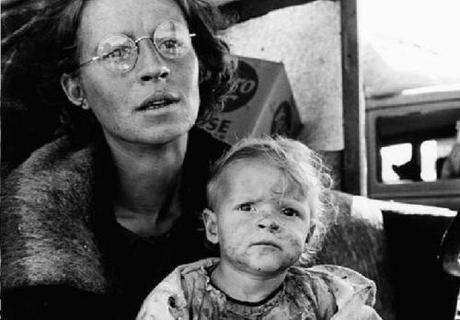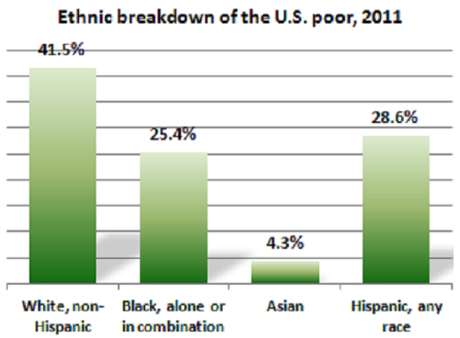
The propaganda from the Main Stream State Controlled Media about an economic “recovery” is just that — propaganda.
We’re not even in an economic recession any more.
America is in a second Great Depression. And the face of the Second Great Depression increasingly is white.
According to an article by the Associated Press, titled “Signs of Declining Economic Security,” survey data “exclusive” to the AP show that a shocking 4 out of 5 U.S. adults are jobless, near poverty, or rely on welfare for at least parts of their lives.
Economic hardship is particularly on the rise among “white” Americans, their pessimism about their families’ economic futures at the highest point since at least 1987. In the most recent AP-GfK poll, a majority of whites (63%) call the economy “poor.”
Economic insecurity among whites also is more pervasive than is shown in government data: As many as 76% of white adults have experienced or are experiencing economic insecurity by the time they turn 60, according to a new economic gauge being published next year by the Oxford University Press. The gauge defines “economic insecurity” as experiencing unemployment at some point in their working lives, or a year or more of reliance on government aid such as food stamps or income below 150% of the poverty line.
Measured across all races, the risk of economic insecurity rises to 79%, which means as many as 4 out of every 5 U.S. adults are jobless, or living near poverty, or dependent on welfare.
If those trends continue, by 2030, close to 85% of all working-age adults in the U.S. will experience bouts of economic insecurity.
The reason why we know less about struggling white Americans is because they are “the invisible poor.” Unlike racial minorities who tend to live in big cities like Detroit and Chicago, lower-income whites are generally dispersed in suburbs and small rural towns — in Appalachia, the industrial Midwest, and across the heartland — where more than 60% of the poor are white.
William Julius Wilson, a Harvard professor who specializes in race and poverty, noted that despite continuing economic difficulties, minorities have more optimism about the future after Obama’s election, while struggling whites do not. Wilson warns, “There is the real possibility that white alienation will increase if steps are not taken to highlight and address inequality on a broad front.”

- Whites (over 19 million) account for more than 41% of America’s poor, subsisting on $23,021 or less for a family of four. In fact, the number of poor white Americans is nearly double the number of poor blacks.
- In 2011, 12.6% of adults in their prime working-age years of 25-60 lived in poverty. But measured in terms of a person’s lifetime risk, a much higher number — 4 in 10 adults — falls into poverty for at least a year of their lives.
- The risks of poverty has been increasing in recent decades, particularly among people in their peak earning years of ages 35-55. For that age group, their risk of poverty increased from 17% during the 1969-1989 time period, to 23% during the 1989-2009 period.
- For the first time since 1975, the number of white single-mother households living in poverty with children now equals or even surpasses the number of blacks, spurred by job losses and faster rates of out-of-wedlock births among whites. White single-mother families in poverty stood at nearly 1.5 million in 2011, comparable to the number for blacks, and more than the 1.2 million Hispanic single-mother families.
- More children — 1 in 10 — are living in high-poverty neighborhoods, defined as those with poverty rates of 30% or more. This puts the children at higher risk of teen pregnancy or dropping out of school. Among those at-risk children living in high-poverty neighborhoods:
- 17% are nonHispanic white, an increase of 4% from 13% in 2000, even though the overall proportion of white children in the U.S. has been declining.
- 39% are Latino, an increase of 1% from 2000.
- 37% are black, a sharp decrease from 43% in 2000.
- Going back to the 1980s, never have whites been so pessimistic about their futures, according to the General Social Survey, which is conducted by NORC at the University of Chicago. Just 45% say their children will do better than them, based on the way things are in America. That percentage increases to 49% among working-class whites. In last year’s presidential election, Obama won the votes of just 36% of working-class noncollege whites, the worst performance of any Democratic nominee among that group since 1984.
H/t FOTM’s Igor.
~Eowyn

